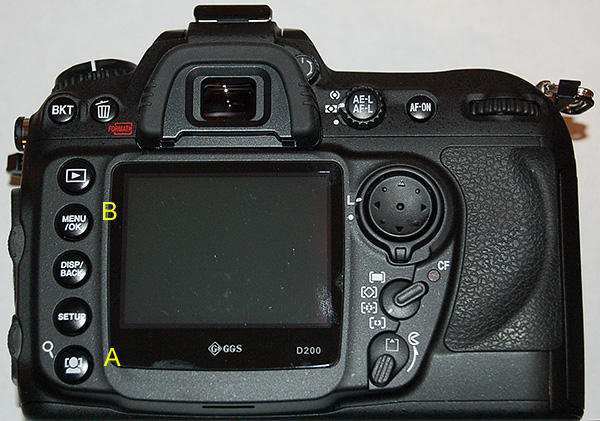
Quick Look: Assessing the Live View mode of the Fujifilm S5 Pro (or S3 Pro) feature for photomicroscopy.
by David Walker, UK
The ability to focus a live image with a DSLR using the so-called Live View facility has become an increasingly popular feature in current models and can also be valuable for photomicroscopy. All the major camera makers now have models in various price ranges with this feature. For potential DSLR buyers looking for a Nikon mount Live View DSLR camera, a model in the 'entry level' range doesn't currently exist but is offered in the mid-range Nikon D90 and D300.
When purchasing a DSLR it can be more cost effective to consider a slightly earlier model as the depreciation can be considerable. The Nikon mount Fujifilm S5 Pro based on the highly regarded D200 body is a prosumer camera with an initial price tag in four figures when released in January 2007 but can now be bought for less than half its original price and less used, putting it in a price bracket not far off Nikon's current 'entry level' DSLRs with much less advanced specs. The earlier model the S3 Pro, also a well regarded camera, is good value if sought used e.g. on eBay.
One feature in the S3 Pro / S5 Pro that wasn't widely regarded as very practical for normal photography (judging from online camera forums) is its 30 second live view feature, which can be displayed either on the camera's LCD or externally on TV or PC. This feature may be more useful for photomicroscopy and the author was interested in comparing it to the up to 1 hour Live View on a Nikon D300 which the author was very familiar with. Some experiences with this feature are presented below using an S5 Pro camera borrowed from a colleague.
The many other features of this camera aren't addressed, but worth noting that Fuji's 'Super CCD' sensor' in the S3 Pro / S5 Pro was stated by the makers to have an 'expanded dynamic range'. A 9 EV dynamic range is typical of a modern DSLR, e.g. see DPreview's Nikon D300 tests, but the same site testing the S5 Pro remarked that 'almost 12 EV' was possible from a jpeg image with 'careful exposure'. Apparently the Fuji sensor DSLRs have proved particularly popular for subjects with demanding shadow / highlight retention such as in wedding photography; some photomicroscopy imagery can also have a tricky dynamic range so may be a valuable feature.
Live View use on camera

The Live View mode is quickly implemented using the feature buttons 'A' and 'B' on the camera back shown above for the S5 Pro.
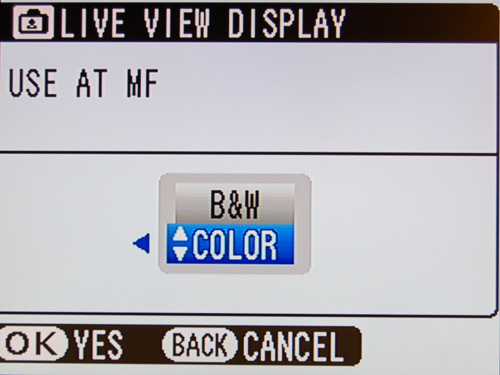
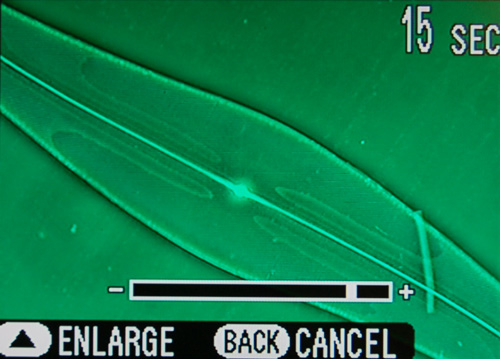
After
pressing button 'A', the screen left above is displayed,
to choose whether colour or monochrome live view is
used. Only monochrome is offered on the S3 Pro and implementation
on the earlier body differs, but judging from the S3 Pro online
manual, is straightforward.
Button 'B' (OK) activates the live view shown
right above. A 30 sec countdown for the live view is displayed which is invaluable.
The
brightness of the live image on screen can be adjusted but is
unrelated to the captured image exposure.

By pressing the rocker buttons on the camera the magnified or full frame view can be chosen. I liked this two mag feature, it's simple and works well. Note that the often demanding high contrast range of a diatom in phase is shown without burn out.
Live View on TV
To capture the above LCD screen shots, the composite video out was fed to a TV to photograph which also provided an opportunity to asses the practicality of live view on a TV. The image quality looked good enough and a small TV eg LCD next to the microscope / camera could be a potential way of using the feature.
Live View on computer plus remote camera control
The Live View can be displayed on a computer and camera controlled remotely using the Fujifilm Hyper Utility V3 software. Unfortunately this isn't supplied with the camera and can be typically £70 new, but original CDs are available for half this price from suppliers.
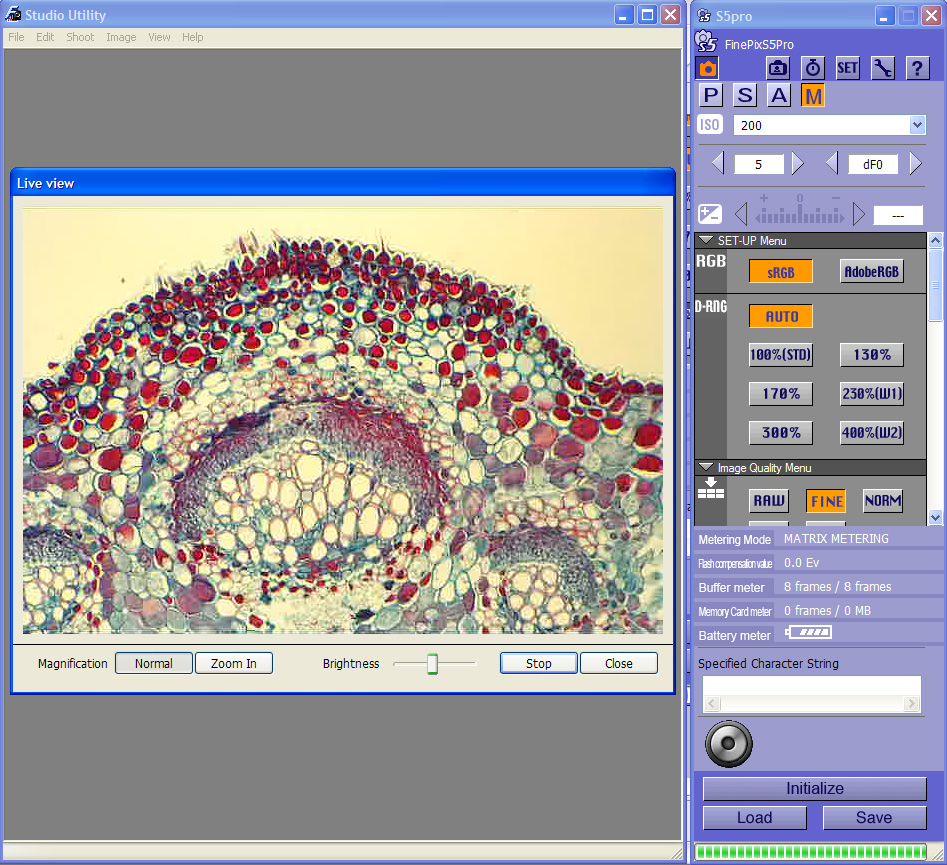
Above: Computer
screen shot of the Hyper Utility software showing the camera controls window.
Both the Live View image and image captured on shutter release are shown
displayed in Studio Utility window which
auto loads. (The camera white balance hasn't been set, hence the off-white
background.)
The camera controls are simply presented and preferred the implementation to that of Nikon's Control
Pro 2 for their own DSLRs which uses tabbed menu features.
The 'Set-up' scrolling
box provides remote access to most camera features, including Fuji's dynamic range options for
this sensor and five customisable white balance settings; the latter potentially
useful for different microscopy lighting setups.
A histogram of the captured
image can be displayed, not shown here.
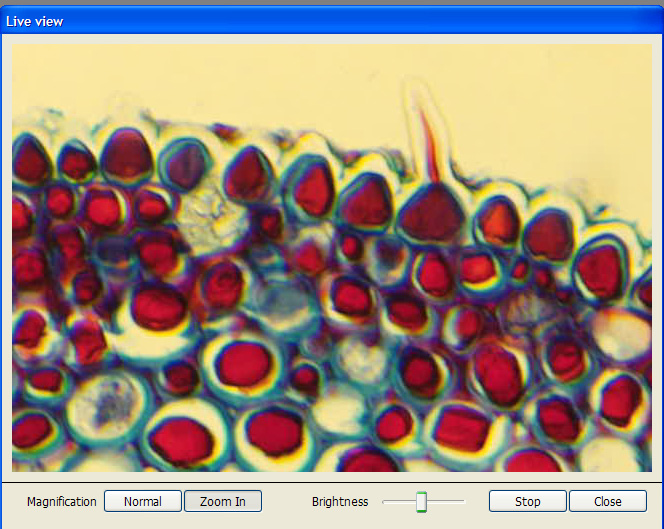

Left above: The
live view can be zoomed in on the screen for critical focus, compare this
zoom-in shot to full view above. Unfortunately the useful 30 sec countdown
clock seen on the camera LCD isn't shown in the computer software. The zoom
in area is for the image centre and not a selectable area as featured
in DSLRs with a dedicated live view feature like the D300.
Right
above: The Fujifilm S5 Pro is based on the Nikon D200 body which allows
metering with lens off in aperture priority mode. Microscopy subjects may
not give spot-on exposures with the metering but the exposure compensation
bar below allowed corrections.
The camera release is the button at base.
A neat feature is the ability to create a sub-folder name for image
storage using the 'character string' box. e.g. 'diatoms', 'desmids' etc
if wishing to sub-divide image types.
The on screen live view image looked
good, although Fujifilm
have a camera firmware upgrade 1.09 (not tried) that they state gives 'better image
quality of 'live view'' on screen.

Diatom
Cymbella gastroides, Watson slide. Zeiss 40X NA0.75 Neofluar phase
objective.
Camera's Dynamic Range on Auto, holds the sometimes
burnt out bright areas of phase images well.
Color and Saturation
in camera set to Standard gives good saturated images out of camera.
Levels on this and image below out of camera.
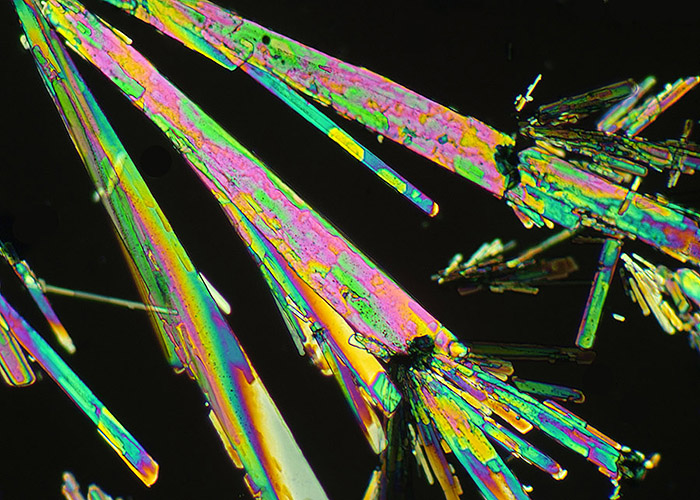
Quinine, Victorian
unnamed mount, Zeiss 10X NA0.22 planachro objective, crossed polars.
Camera
settings as above.
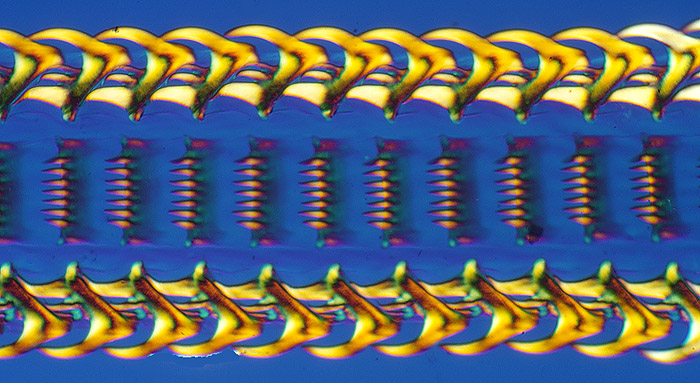
Palate of whelk, Victorian mount by Wheeler. Zeiss 2.5x planachro objective, crossed polarisers and lambda plate.
Comments
As remarked, this was a 'quick look' on a borrowed camera, but the live view looks potentially useful for photomicroscopy if considering this model for general photography. The viewfinder can be used for general composition and initial focus, with the 30 sec live view providing critical focus. The feature can also be useful for initially setting up the camera to be critically parfocal with the microscope.
To check both the viewfinder image and live view image with ease, the camera's LCD back may be most convenient for live view or a TV / computer adjacent to the microscope for remote imaging. The camera's LCD was too high on the author's Zeiss research stand for comfortable use but putting a right angle prism or mirror on the LCD can circumvent this as the author did for the D300.
Live subjects may have to be efficiently immobilised as the short duration of the live view feature may make it awkward to track a subject. The S3 Pro / S5 Pro models don't have a dust removal feature on the sensor unlike most modern models with live view so uncertain if dust build up may be a problem.
If extended live view is an important feature and a Nikon mount wasn't crucial, the more recent DSLR models would probably be better, eg those by Pentax, Olympus or Canon in this price range.
Comments to the author David Walker are welcomed.
Acknowledgement: Thank you to a colleague for the kind loan of the camera.
Published in the October 2008 edition of Micscape.
Please report any Web problems or offer general comments to the Micscape Editor .
Micscape is the on-line monthly magazine of the Microscopy UK web site at Microscopy-UK
©
Onview.net Ltd, Microscopy-UK, and all contributors 1995
onwards. All rights reserved.
Main site is at
www.microscopy-uk.org.uk
with full mirror
at
www.microscopy-uk.net
.